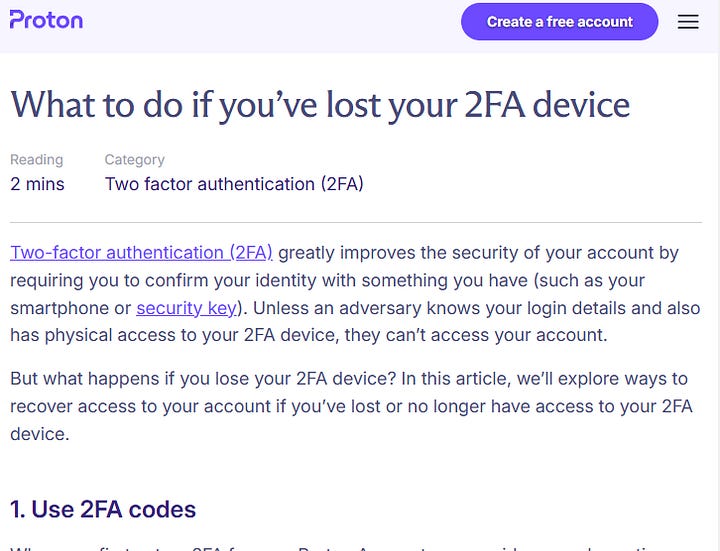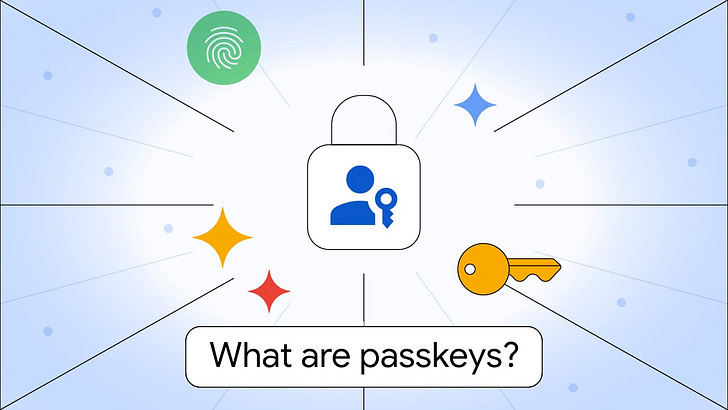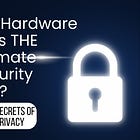Lost Your Hardware Security Key? Here Are Your Options (plus bonus question)
Don’t panic! Here’s what to do when you lose your 2FA key
Our post on passkeys is turning into an unintentional series on authentication, 2FA and passwords. That post is available here:
At the request of some readers, we then followed up our post on passkeys with one on hardware keys, available here:
A few other readers reached out with an important question (hesitation?) about hardware keys – what happens when you lose the key?
We touched on that in the original post, but we’ll go into greater detail here given the importance of this issue. We suspect the concern over losing a hardware key is a significant barrier to wider adoption. It was probably our biggest concern.
If you lose track of your hardware key, you have three primary options:
Use a backup key
Use an alternate authentication method(s)
Contact customer support for the impacted account
1. Use Your Backup Key
We mentioned a few times in our hardware key post to have a backup key. It’s the simplest way to minimize the fallout of losing your primary hardware key. If you’ve already registered a backup key with your accounts, simply grab it from its secure location and use it as normal. Most services allow you to register multiple keys during setup, so your backup will work seamlessly without any additional steps.
What happens if you didn’t make a backup key or the backup key is lost or damaged?
2. Rely on Backup Authentication Methods
Let’s say you didn’t create a backup key. It’s not a disaster, but things will be more complicated. Most platforms offer alternative ways to log in. These might include:
Authenticator Apps: Apps like Ente Auth (which is what we use) can generate time-based codes for login.
Backup Codes: Many services provide one-time-use recovery codes during setup— check if you saved these in a secure place.
SMS or Email Verification: Some accounts may fall back on sending a verification code via text or email.
3. Contact Customer Support (If Necessary)
This is the (potential) disaster zone. For accounts with no other recovery options, you will need to contact the service provider’s support team. Be prepared to verify your identity through additional steps, such as answering security questions or providing proof of ownership for the account. Some services may require you to film yourself. Keep in mind that recovery processes can vary widely between platforms and may take time.


Updating Your Security Settings
Once you regain access to your account, it’s important to update your security settings as quickly as possible:
Remove the lost hardware key from your account to prevent unauthorized use if it’s found by someone else.
Register a new primary and backup key as soon as possible to restore your layered security setup.
Preventing Future Lockouts
To avoid the stress of losing a key, here are some proactive measures:
Always register at least two hardware keys with every account that supports them.
Store your backup key in a safe but accessible location (like a fireproof safe).
Keep track of any recovery codes provided during account setup—they’re your safety net in emergencies. These can be stored in a hardcopy form or in an encrypted password manager.
While losing a hardware key can be inconvenient, proper preparation ensures it won’t turn into a full-blown crisis. The key is redundancy—having multiple ways to regain access keeps your digital life secure and accessible, no matter what happens.
Can’t a Hacker Create a False “Lost Key” Claim to Access My Account Through a Weaker Authentication Method?
Many of you probably picked up on this.
A Bad Actor could try to access your email account, claim the key is lost, and then try to gain access via a less secure method. This is a legitimate risk and the likelihood of success will depend on how the particular platform handles account recovery and alternative 2FA methods.
If a bad actor tries to claim your key is lost, here’s what happens:
Platform Safeguards – Many services implement strict verification before allowing fallback methods. For example, a platform may require:
Verification of recent account activity
Previous passwords
Access to a known device or location
Delayed Recovery – Some platforms impose a waiting period (e.g., Google’s recovery can take days) to prevent immediate takeovers.
Stronger Recovery Methods – Some services let you disable less secure options like SMS or email recovery, forcing all authentication through hardware keys or an authenticator app.
Even with this being a legitimate risk, we don’t think it’s significant enough to discourage the adoption of a hardware security key. Especially if you’re at a higher risk of targeting where you need the highest form of security possible for your key accounts.
Wrap Up
Hopefully that helps clear things off and you feel a little bit more comfortable trying out hardware keys. We do think they’re worth the extra effort for higher risk accounts like social media accounts since the fallout there from a hijacked account is so severe.
Still have questions, send a direct message or add it to the comments.
📌 P.S. If you found this post helpful, would you please consider restacking it and sharing it with your friends, family and audience?
This helps spread the words and keeps us writing content that will help you bolster your privacy and become a harder target.
Looking for help with a privacy issue or privacy concern? Chances are we’ve covered it already or will soon. Follow us on X and LinkedIn for updates on this topic and other internet privacy related topics. We’re also now on Rumble and YouTube. Subscribe today to be notified when videos are published.
Disclaimer: None of the above is to be deemed legal advice of any kind. These are *opinions* written by a privacy attorney with 15+ years of working for, with and against Big Tech and Big Data. And this post is for informational purposes only and is not intended for use in furtherance of any unlawful activity.
Privacy freedom is more affordable than you think. We tackle the top Big Tech digital services and price out privacy friendly competitors here. The results may surprise you.
Check out our Personal Privacy Stack here.
Online photo storage is a privacy trap. Get the low down on how to store your photos in a privacy friendly way here.
Looking to De-Google your life? Proton is one of the best ways to get there. Get started here with a paid plan for around $1/month. (affiliate link)
If you’re reading this but haven’t yet signed up, join the growing Secrets of Privacy community for free and get our newsletter delivered to your inbox by subscribing here 👇



